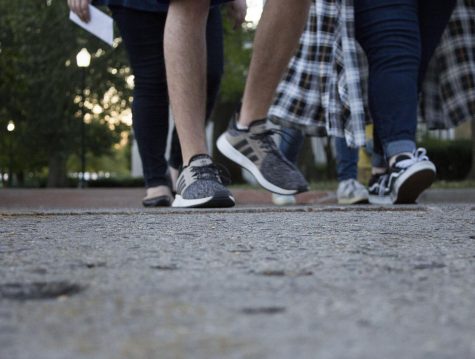Walk to School Day: Earth Wise president explains how global event helps environment
October 1, 2019
Students who honor Walk to School Day on Wednesday by commuting to school on foot or via bicycle can save money while helping the environment.

Photo Illustration
Walk to School Day is a global effort that focuses on safe transportation for all students, and emphasizes that traveling by foot promotes good health, according to the National Center for Safe Routes to School.
Miranda Martinez, a sophomore communication disorders and sciences major and president of the Earth Wise Club, said walking or biking to school makes a bigger difference to the environment than people realize.
She said the more students drive to school, the more carbon dioxide emissions are released into the Earth’s atmosphere.
According to NASA, carbon dioxide is the chief gas for temperature control. Carbon dioxide, along with methane and halocarbons, are greenhouse gases and absorb a variety of energy types that are emitted and re-emitted.
“Without greenhouse gases, Earth would be a frozen -18 degrees Celsius (0 degrees Fahrenheit). With too many greenhouse gases, Earth would be like Venus, where the greenhouse atmosphere keeps temperatures around 400 degrees Celsius (750 Fahrenheit),” NASA says.
Scientists can calculate the atmosphere’s gas concentration and how much each contributes to global warming, according to NASA; carbon dioxide contributes to about 20 percent of the greenhouse effect.
Carbon dioxide emissions are increasing, thus increasing the planet’s temperature, according to NASA.
“Rising carbon dioxide concentrations are already causing the planet to heat up. At the same time that greenhouse gases have been increasing, average global temperatures have risen 0.8 degrees Celsius (1.4 degrees Fahrenheit) since 1880,” NASA says.
Martinez said the increase in carbon dioxide emissions negatively affects plants on Earth.
“(Carbon dioxide emissions) take away from natural emissions … we have so many (emissions) from just all the people living on Earth and just the animals, that it’s kind of overwhelming for the plants to take in, so that does harm the atmosphere,” she said.
Martinez said the way people get the carbon dioxide gas could vary. One way to get it is by fracking, and that has the potential to pollute different water sources, she said.
In addition to helping the environment, the students who participate in Walk to School Day by ditching their cars to get to school on foot save money that they would otherwise spend on gas, Martinez said.
Some college students, including Martinez, do not own cars at all. In general, owning a car is expensive because it entails paying for repairs, gas for transportation and insurance, among other possible costs like parking passes, Martinez said.
Besides saving money, walking or biking to school is a healthy activity, she said.
Many college students have full schedules and do not have time to go to the gym everyday. Walking or biking to and from school may not be a total substitute for a gym workout, but it can certainly help, Martinez said.
For students who live far away but would still like to participate in Walk to School Day, Martinez said carpooling with friends or using public transportation are good options. These modes of transportation also help reduce carbon dioxide emissions, but not as much as walking or biking to school, she said.
Martinez said students should consider taking at least a temporary break from driving to school because it can positively affect so many different factors in people’s lives.
“If we have one day where everyone were to just take a break from using their car to drop their kids off … that would be so helpful for the Earth, and it would just be altogether better for everyone,” Martinez said.
Logan Raschke can be reached at 581-2812 or at [email protected].


















































